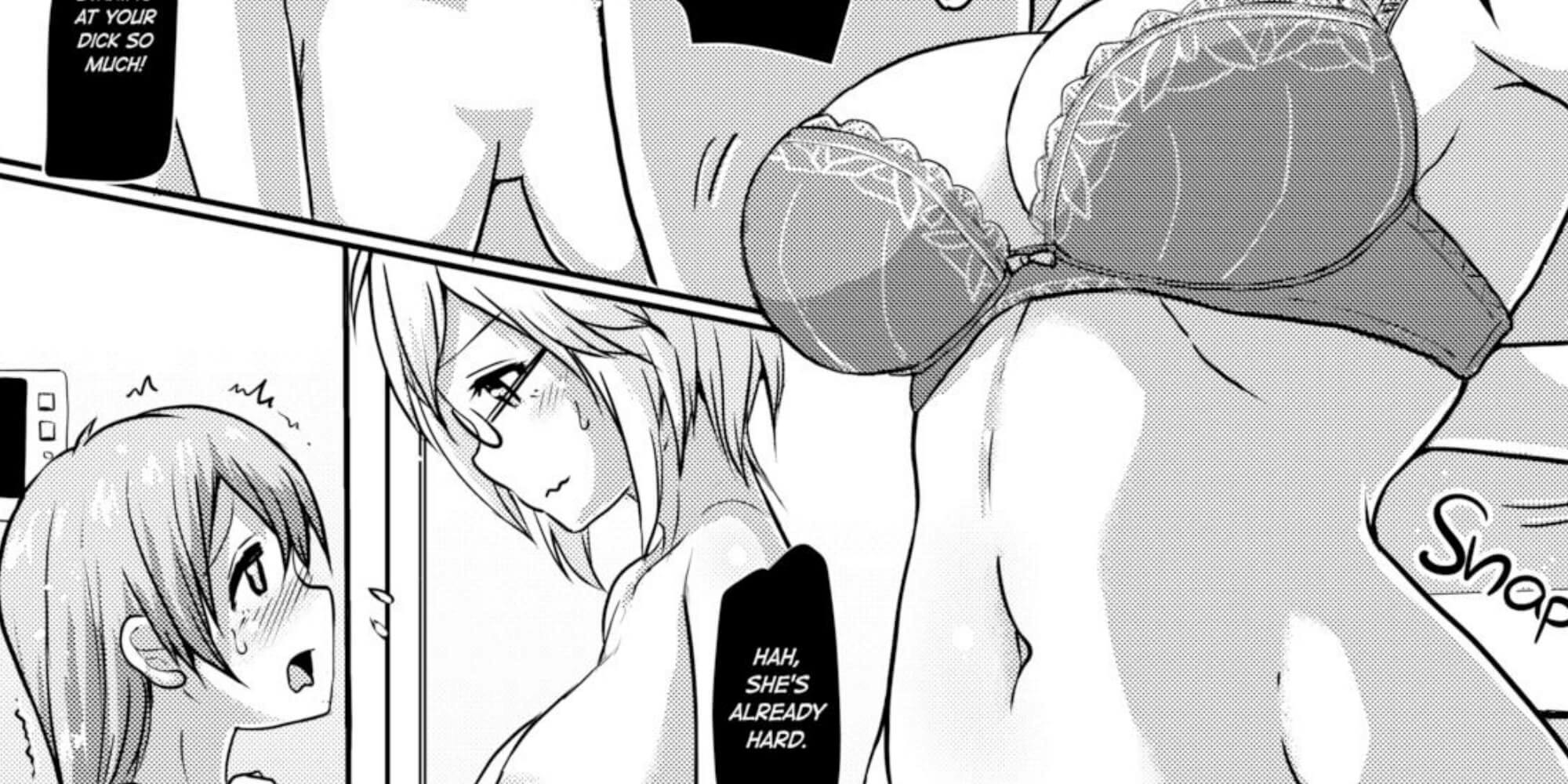If you live in New York, New Jersey, Texas, Washington, Nevada, or Florida, then congratulations: Your state loves futanari. Fakku’s 2019 Year in Review reveals that futanari is by far the most popular anime porn genre in the U.S.
Futanari, or “futa,” is a Japanese hentai category involving women with penises. More specifically, futa women’s penises function identically to cisgender men’s: They become hard and erect, and many futa women use their dicks to penetrate their partners.
One Fakku manga, “Mirth Legend,” involves a magical dancer who seduces a heroic adventurer and has vaginal sex with him before forceful anal penetration. “Your Wish, My Wish” involves a mother-daughter genie pair who recreate their master’s demand for a futanari incest hentai.
Not all futa hentai feature themes of nonconsent and taboo—but shock, anxiety, hesitation, and dubious consent are common in many futanari storylines. And depending on one’s gender, sexuality, and geographic locations, an interest in futanari might have vastly different implications.

At first blush, American readers may think futanari is a metaphor for trans bodies, but Japanese culture critic Haru Nicol warns this isn’t necessarily how the genre is perceived in Japan.
“[Futanari is] never really trans-coded, it’s always seemed to me as like, ‘here’s a hot girl with a dick,’” Nicol told the Daily Dot. “Personally, I’ve always seen futa as SUPER fetishistic, similar to the idea of ‘traps.’ So it doesn’t carry the trans-coding for me because of the straight, cis, male artists’ intent. Though I’d love to see more trans-coded futa!”
The term “futanari” literally means “to be of two kinds,” and it was traditionally a general term for androgyny in Japan. Over time, futa has more or less turned into a hentai term for “cis passing girls with either a vagina and a penis, or just a penis,” Nicol said. “Trap” is a transphobic term used to describe either a character who appears one gender but is actually another (i.e. a crossdressing boy), or as derogatory slang for an attractive trans woman who passes as cisgender.
“There is a more specific term for trans (usually women) people which is ‘newhalf,’” they explained. “Newhalf and futanari are like two separate ideas if you get what I mean.”
Western misconceptions are common around hentai, its popularity, and what sexual desires are actually mainstream in Japan. Nicol, who is trans nonbinary and grew up in Tokyo before moving to the U.K., recalls vanilla hentai being readily accessible in the city’s convenience stores. But this isn’t the case with futa, which is only for sale in stores for otaku (or hardcore anime fans) or retailers that sell doujinshi (or indie manga).
Emma Kidwell, a Japanese-American games journalist who regularly writes about Western culture and Japan, stresses Americans tend to assume out of ignorance and stereotypes that futanari is “the norm” in Japan.
“I’d say it’s popular because it’s taboo in both America and Japan—the latter still having archaic views on sexuality and gender expression (although that’s changing with the youth!)” Kidwell told the Daily Dot.

Futa’s popularity in the West is a bit of an intersectional headache for queer culture writers, hentai fans, Japanese anime critics, and those that sit at the intersection of all three. As trans rights become more mainstream, futa represents a trans-coded sexual fantasy that detours from straight, cisgender men’s anxiety around sexual attraction to trans bodies. Futa women are more or less coded as cisgender by Western readers, so it’s not quite as sexually compromising for a straight man to read futanari hentai than for him to watch porn with trans women. Kidwell also points out how fetishism is a little bit more acceptable to hentai readers because of its alternative nature.
“Hentai is ‘weird’ to a lot of Americans because it’s not traditional porn, right? So if you’re already in weird territory, might as well explore the weirdest parts of it,” Kidwell said. “It’s all fantasy, but it’s safe too. You’re safe to explore what you’re curious about, even if it’s highly sexualized and unrealistic.”
But that’s just one part of futa hentai. Western readers, particularly cis straight men, might actively seek out futa hentai because it sits in dialogue with their fetish for trans women’s bodies, complete with the inaccurate belief that trans women’s penises functional identically to cisgender men’s.
This seems to coincide with the surge in trans porn searches on tube sites. In 2017, Pornhub found searches for transgender-related porn have gradually increased since 2014. Many of the states that searched for futa porn on Fakku also searched for trans porn in high numbers on Pornhub, including Florida, Nevada, Connecticut, and Massachusetts.
Again, in both cases, this doesn’t necessarily mean these viewers appreciate or respect trans women and their bodies. Nicol points out how futanari, especially as it’s perceived in the West, can be “deeply fetishistic and gross.”
“It propagates an ideal of cis passing and how being trans is a sexual thing. Plus it’s trap adjacent a lot of the time so there is all that,” they said. “I feel like futa is different from a genuine work of pornography from a trans woman since like, futa is so much more for the cis male gaze.”

But there’s a third component to futanari, which is how trans feminine people engage with it. In recent decades, many queer trans women first learned about their gender, sexuality, and trans sapphic desires through exposure to futa porn, writer Sam Riedel notes. She “saw too much of [herself] in the shy-but-slutty futas and femboys” seen in Western futa artist InCase, whose series The Invitation remains popular with trans women. Some trans women have embraced certain tropes or ideas from futa hentai, such as the penetrative futa domme or being a “dickgirl,” and regularly use it in our sex lives.
“My ideal high femme domme is literally the Master from The Invitation by InCase,” this reporter once tweeted. “When I die and become a demon goddess, this is how I’m gonna be.”
That’s not to say futa is a reclaimed term, or that every trans woman agrees futanari porn is redeemable. But futa has historically played an important role in many American trans feminine peoples’ coming out as a cultural symbol that, while alternative and taboo, could still be queered into a vessel for trans representation.
This legacy lives on in trans porn. Trans sex workers and adult creators occasionally play with futa aesthetics in their content, just as many adult performers toy with ahegao (a hentai trope involving all-encompassing, overwhelming orgasms) in their work. Trans artists like Thirty Helens stress futanari and trans bodies are “inherently linked” because futa bodies “resemble our bodies,” as Riedel quotes in her essay. Therefore, cis peoples’ trans panic around attraction to futanari material needs to go.
Trans sex worker Emma Pines says aesthetics inspired by futa hentai, such as the penetrative “dickgirl,” regularly appear in her adult content. “Times when I fill a dominant role [in my work] can definitely incorporate aspects of that perverted, in-control-woman aspect that’s popular,” she told the Daily Dot. “Maybe not predatory but definitely like, eager.”
But if we want to understand futanari’s trans-coded elements in the West, we also have to accept that futa means different things to different people. It can be an invitation to think deeper on who we are and how gender, culture, nationality, sexual desires, or a lack thereof shape the content we consume.
“Reading and watching hentai is totally OK and nothing to be ashamed of,” Kidwell said, “but we should all remember it’s fantasy and not indicative of the culture or people where it’s produced.”
“Futa didn’t make me a dyke-y trans girl. It just helped me realize that’s who I wanted to be,” Riedel says. “Hopefully, it will help other fledgling dickgirls realize it sooner than I did.”

